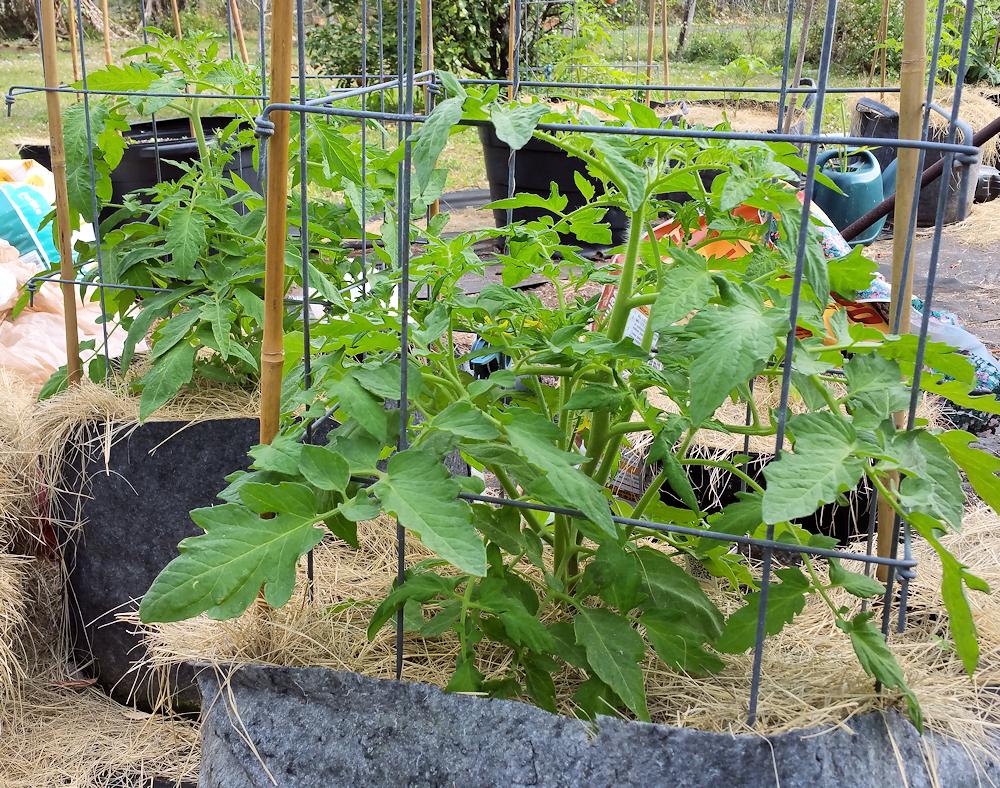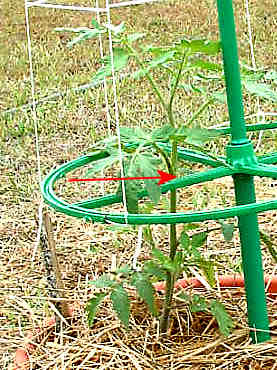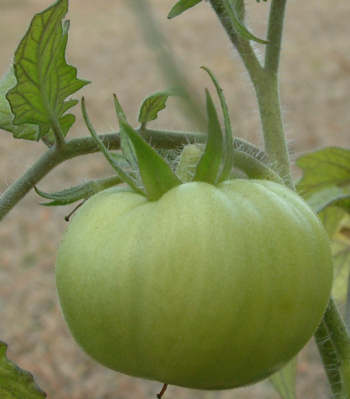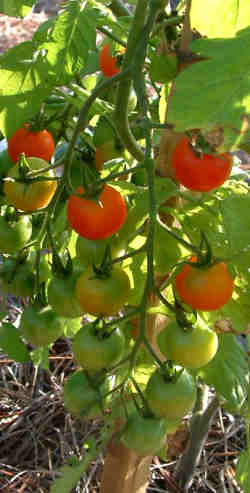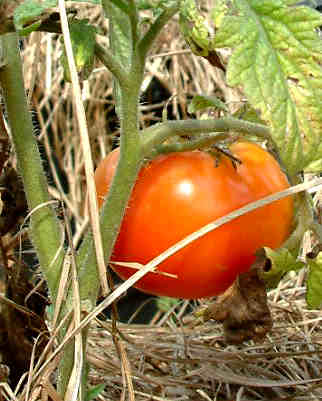Tomato Cages
If you plan to grow large vining tomato plants, you may want to use tomato cages. What exactly is a tomato cage, though, and how do they work?
What is a Tomato Cage?
A tomato cage is a generic term for a tomato plant support, that supports the plant on at least three sides. A tomato cage can be round, square, rectangular or triangular, although square tends to be the most popular.
Some tomato plants have a vining growth habit, others have loads of fruit, and yet others have huge fruits. And then of course, there are tomato plants that have two or all three of these!
You don’t want tomatoes – plant or fruit – resting on the ground. It’s too easy for insects to find and munch, not to mention plants on the ground are more susceptible to tomato diseases. That means either staking or tomato cages are your best options in most cases.
When to Cage Tomatoes
Many tomato plants can be staked, with one or perhaps two stakes. Then tie the plant’s branches to the stake(s) at various heights so that the plant stays upright.
But there are plants whose growth is too tall or “sprawly”, and they need more support than one or even two stakes. This is where tomato cages can come in handy. (Of course, you can cage any tomato plant you like.)
Determinate tomato plants bear the vast majority of their fruits in a short period of time. These plants can get very top-heavy, and sometimes stakes don’t provide enough safe support for all those ‘maters!
I usually stake most of my tomato plants, but the bigger plants get caged, as I’ve learned through experience. Don’t be like me and have a tomato plant split because the support from the stake just wasn’t enough. Tomato cages give support at multiple points instead of just two or three.
Big Tomato Cages
There’s another tomato cage that I have just ordered in preparation for The Great Tomato Experiment is the tomato tower with nylon trellis. It’s a larger type of “cage”, rising to 6 feet tall – great for the larger tomato varieties. Which I fully expect to have with the experiment!
I prefer the square cages, but I am open to experimentation. 😀 I do like tall tomato cages, though, and they tend to be harder to find.
Now there are plenty of tomatoes that can be staked, like the smaller determinate plants. For these tomatoes, you can use a stake or a tomato pen (like the first photo on this page). You’ll want the pen 30 to 40 inches tall, or a stake 3-1/2 feet tall for these varieties.
Hope this gives you enough information on whether you can stake your tomatoes or if you should have tomato cages for them. Either way, enjoy eating your delicious homegrown tomatoes!
Tomato Varieties for the Southeast
Tomato varieties for the Southeastern USA are pretty wide-open for most locations, but there are certain considerations. I thought I’d start some posts about tomato varieties well-suited for different locations around the USA. And this, my first post, is on the Southeastern USA.
What is the South East?
Well, here are the boundaries I’m considering the Southeast:
- South of Virginia on the eastern seaboard
- East of Texas
- South of Kentucky in the middle part of the USA.
- I’ll include Arkansas, but exclude Missouri.
So now that we know the boundaries, what tomato varieties are good for this area? Let’s consider the two things common to Summer in most of these locations.
Heat. Humidity.
While a little of both are great for growing tomatoes, too much of a good thing spells bad news for your eventual fruits. So what kind of problems do the heat and humidity cause in the Southeastern USA?
Yikes! There’s a Fungus Among Us!
Unfortunately, fungus thrives in humid locations without good air circulation. Diseases related to fungal infections include alternaria, blights, gray leaf spot, fusarium wilt, damping off, verticillium wilt, mold….you get the idea.
If you are finding a lot of fungal infections in your plants, you’ll want to at least think about some hybrid tomato varieties that are more resistant to these problems. You’ll recognize them by the letters after the tomato name; they include:
- A – alternaria
- F – fusarium wilt strain I
- FF – fusarium wilt strain I & II
- V – verticillium wilt
So for example, if you look at the description for the tomato variety called Big Beef, you’ll see the letters VF1F2TNA, which means the tomato is resistant to alternaria, both strain 1 and 2 of fusarium wilt, verticillium wilt, tobacco mosaic virus (the “T”) and nematodes (the “N”).
Other hybrid tomato varieties with good fungal resistance include:
- Applause (ASCF1F2StV)
- Celebrity (VF1F2NTASt)Â (one of my favorite hybrids)
- Country Taste (F1F2TV)
- Fabulous (VF1F2TASt)
- Razzleberry (VF1F2)
So this gives you an idea of what to look at when evaluating one of the tomato hybrids. (In addition to taste, of course.)
Other Tomato Diseases
Unfortunately, fungal diseases aren’t the only ones to threaten our homegrown tomatoes. We also have to worry about bacterial diseases (bacterial speck, spot, wilk, canker, fruit rot, etc.). And if that wasn’t bad enough, we have nematodes and viral diseases. It’s a wonder that we have any tomatoes at all!
The chances of bacterial diseases can be greatly reduced by careful mulching, as it’s the bacteria in the soil that causes problems. Nematodes…well, if you have them in the soil, the best thoughts would be to either plant your tomatoes in containers (using potting soil) and/or plant hybrids that are resistant to nematodes. Viral diseases can also be present – yikes!
(You may want to read the post on tomato diseases to become more familiar with these banes to growing tomatoes.)
What About Heirloom Tomatoes?
Sure, you can grow heirlooms! Just keep in mind that because they since they don’t have all those extra letters after their name, you’ll not know right off the bat what kind of resistance a variety has. You’ll need to be more on the lookout for any problems. Make sure your plants have plenty of air circulation (without being too windy), mulch the soil and consider growing in containers if you have a problem with nematodes. Oh, and don’t splash water on the plants when watering.
If you live in a location where it’s hot but not necessarily humid, you have more wiggle room in the summer. But of it’s really hot, you’ll want to pick tomato varieties that set fruits when many days go well over 90 degrees. The big beefsteaks are usually a little more trouble in this respect, compared to the tomatoes which grow to be less than 8 ounces.
Heirlooms that seem to do well in the southeast heat and humidity are:
- Cherokee Purple
- Black Krim
- Black Prince
- Bradley
- Clear Pink Early
- Matina
- Just about any cherry tomato
Where I live in South Florida, I try to grow most of my heirloom tomatoes on the “shoulders” of the season. In other words, I do my best to avoid having the fruit trying to set between mid-July and mid-August, when it’s the hottest. This may mean starting the seeds earlier than normal so I can get the seedling plants outside at the first possible moment.
Hybrid Tomatoes
Hybrid tomatoes sometimes get a bad rap. While I will agree that most heirloom tomatoes have a better overall taste, let’s face it – any homegrown tomato will taste better than one from the grocery store!
So why are hybrid tomatoes looked down upon at times? Are they truly worth growing? And what makes a hybrid different from an open-pollinated tomato?
What Are Hybrid Tomatoes?
As you probably know, a hybrid is a cross. The hybrid tomatoes are simply crosses between two different varieties to create a third.
So why make these crosses? Here’s one reason — a particular tomato variety may have superior disease resistance, but the tomatoes produced aren’t very tasty. Since disease resistance can be crucial for some growers, a cross is made to a tomato with great taste. The resulting cross will include better disease resistance combined with better tasting tomatoes.
Another reason for a cross might be to create a tomato specifically for a very warm or very cool climate.
Here’s something important to note; if you plan to save seeds from your crop, don’t bother with a hybrid. This is because the seeds can resemble the “grandparents” more than the parent plant — in other words, they might be great or they might be tasteless. The magic only happens when the two varieties are combined.
(On the other hand, an open-pollinated tomato is a stable cross over many generations and reproduces itself.)
Hybrids and Taste
I’ll be the first to admit that most hybrids aren’t as sweet as most heirlooms. But if all you’ve ever had are the plastic-tasting tomatoes from the grocery store, a homegrown hybrid tomato will taste like heaven! Still, the hybrid cherry tomato Sungold is just about unbeaten for sweetness — by either hybrid or heirloom! And you can see my Supersweet 100 plant in the photo above — those were tasty cherry tomatoes. 😀
A lot of hybrids are bred for disease resistance or for being early or something like that. Not many hybrids are bred for taste alone, but they are out there! I have the tomato Glory on my list of tomatoes to try this summer, when I grow most of my hybrids.
Why Grow Hybrids?
I live in South Florida, and our summers are brutal here — strong sunlight, very hot and very humid. The combination isn’t great for setting tomato fruits, but is just right for bacterial and fungal diseases. When I grow tomatoes in the summer here, I need the extra properties of the hybrids to keep me in tomatoes!
But if you live in a cool, short-summer climate, you’ll likely be wanting a hybrid that is bred for a cooler climate. An early-season tomato variety bred for cooler weather, like Early Girl. Most heirlooms are later-season plants, and won’t grow fast enough in a short-summer climate.
A good percentage of determinate tomatoes are hybrids, and if you want most of your tomatoes ripe at the same time (like for preserving), then determinates are what you need.
If you plan on growing tomatoes, I suggest that you grow hybrids and heirlooms. Try them both and see what you prefer and what grows best in your particular climate. Like me, you may end up growing both!
Here’s to homegrown tomatoes, no matter what variety!
Germinating Tomato Seeds
Germinating tomato seeds, or more specifically growing tomatoes from seeds, really isn’t that difficult. Using seeds, you can grow a whole lot more varieties than what you find in your local garden shop.
If you’re adventurous, why not try growing a new variety (or varieties) of tomatoes from seeds? Maybe some heirloom tomatoes, while you’re at it?
Tomato Seed Germination Rates
Before I get into the technical aspects of planting, I want to discuss germination rates for tomato seeds. It’s quite rare for all the seeds you plant to germinate, or once germinated, to thrive. While I’m glad when it happens, I don’t expect it. In my experience, 75% to 80% of my seeds in any given packet germinate and thrive. So, I normally plant 25% more than I think I will need of a particular variety. If everything germinates and thrives, I can give away or sell the extras.
A lot of things affect the tomato seed germination rate. For one, how old are the seeds? Whether you buy them online (which is what I do mostly) or pick up the seeds in a garden center, you don’t know how long those tomato seeds have been sitting around. The older the seeds, the lower the germination rate.
(That being said, I have seeds 10 or more years old that still germinate…just slower and with a lower percentage.)
Another issue is how have the seeds been stored? Two things can hurt seeds; too much humidity and…not enough humidity! Too much, and the seeds want to sprout, or else they can mold. Too little and they can dry out and not germinate at all.
How Long Does It Take for Germination?
There isn’t really a set time for tomatoes, as different varieties germinate at different times. The fastest I’ve ever had is 3 days; the slowest 12 days. In general, most germinate in 5 to 7 days. I generally wait 2 weeks before I consider a set of tomato seeds a lost cause for germinating.
Right now, I have SuperSweet 100, Brandywine and White Bush sprouting. SuperSweet 100 raised it’s head after 4 days and at 7 days (which is today), I did the first transplant to a slightly larger container. I had a 75% germination rate with a fairly new packet of seeds. (I planted 4 seeds and 3 germinated.)
White Bush is the next in line, sprouting yesterday (6 days). Brandywine is just starting to poke its head above ground today (7 days). My germination rate is really low with these two, because I am using 10-year-old seeds. (I just did plant some newer Brandywine seeds today for comparison.)
I have about 3 other varieties that haven’t sprouted yet, but once again, these are all 10-year-old seeds. What can I say, I am curious as to how they grow and thrive! Some of my 10-year-old seeds are pretty rare, and I want to try them again.
(Read my update on how well the 10-year old seeds germinated, 10 days out – I was amazed!)
Germinating Tomato Seeds – Tips
First, make sure that you have a nice, warm place for your seeds to germinate. I use a windowsill greenhouse in a south-facing window; some people use the top of their refrigerator. Others use a seed heat mat or a grow light. A soil temperature of around 80 degrees is ideal for tomato seed germination.
The “soil” I’ve had most luck with is a seed starting mix. It’s lighter than a regular potting mix, so it’s easier for the plants to poke their heads above ground. The soil needs to be moist but not wet.
I tend to plant my seeds rather shallow, 1/4 inch or less. Keep the humidity high while you’re waiting for the seeds to germinate. This is where I like the mini greenhouses (windowsill and table-top, because they have a cover that keeps the seeds and soil nice and moist. Not to mention they take up very little space.
I have used jiffy pots and compressed peat disks, with fairly good results. The main reason I don’t generally use them these days is because I plant 5 to 10 different varieties at a time, and I need to label my pots with the variety name. But if you just plan on growing one to three varieties, then the jiffy pots and compressed peat disks work fine.
Once your seeds have sprouted, they need light — from sunlight or a grow light. If you live in a chilly climate, grow lights might be your best bet. Where I live (South Florida), a windowsill works fine just about any time of year.
I hope all these tips have helped, and that you have much success in germinating tomato seeds!
Planting Tomato Seeds Today
Today was a day for tending to my tomatoes. Between planting tomato seeds, re-potting seedlings and transferring larger seedlings to the garden, it’s been busy. But a fun kind of busy, because the weather was gorgeous and it was nice being out in the fresh air and sunshine.
Tomato Varieties – Re-Potted
OK, first was transplanting some small tomato plants up. These were seeds I planted about 3 weeks ago, and they were growing very strongly. These were Supersweet 100, a hybrid indeterminate red cherry tomato. Since I had 3 Supersweet 100 plants, I am running an experiment. One I planted into its final container outside with the rest of the tomato plants. Another I planted up to the next container size and left outside in a location with bright indirect light. The final I planted to the next container size up, and I am keeping it inside, on a south-facing windowsill.
My next plant was a surprise. Some of my 10-year old seeds for White Bush sprouted and one of the seedlings was going for the sky! White Bush is, I believe, a determinate with ivory-colored skin and flesh; I didn’t save a whole lot of information on it so I am not sure (oops). It’s an open-pollinated tomato. So, I planted the strong one by itself the next container side up, and thinned the remaining to the two strongest and placed then together in the next container size up.
Then there was Yellow Cherry, another of the 10-year-old seeds. It’s an open-pollinated indeterminate yellow cherry tomato (pretty obvious from the name), but seems like it will be a smaller plant than Supersweet 100. I thinned the seedlings to the three strongest and planted them up to the next container size.
Planting Tomato Seeds – The Varieties
I also planted more tomato seeds today. Two were for heirlooms, and one for a hybrid I’ve been wanting to try.
The first heirloom seeds planted were Kellogg’s Breakfast, an indeterminate beefsteak tomato with orange skin and flesh. It’s a late season variety, so I don’t expect to be eating any of these tomatoes until sometime in May or June. But I sure am looking forward to them!
The next was the heirloom seeds for the tomato variety called Pineapple. These are the seeds I have planted for The Great Tomato Experiment, so it’s now officially underway! Pineapple is a personal favorite, with the flesh being sweet and delicious. Pineapple is a yellow tomato with red stripes on the skin and red marbling of the flesh.
My final tomato variety I planted seeds for today was Tomatoberry. It’s an indeterminate hybrid tomato whose fruit is roughly the shape and size of a large strawberry. A mid-season tomato variety, I expect to be nibbling on the first ripe fruits in late April. Tomatoberry is supposed to be be really sweet and juicy; I guess I will find out in a few months!
Plants I’m Still Waiting On
Brandywine is taking its time at the moment; lots of seeds germinated (to my surprise) from the 10-year-old seeds. The seedlings are still too tiny to re-pot though. The same goes for Big Rainbow. Both will likely be plenty big next week to re-pot to the next size container.
I had planted some Juliet seeds last week, and when I looked this morning, nary a sprout. I went about my morning chores, then all my garden work. When I came back in a few hours later, I was surprised to see 4 seedlings! Juliet is a grape-shaped cherry tomato, which I do so love to plant, seeing as they are practically foolproof to grow.
Before I leave for the day, here’s a photo of one of my first tomatoes in the garden, on the plant called Celebrity. The tomato is teeny-tiny at the moment, and hopefully it will be joined by others in the very near future.
That’s all for today; see you again tomorrow!
